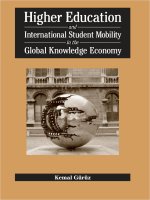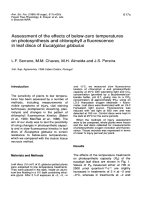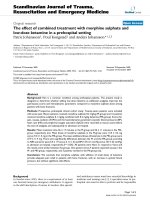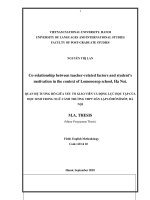The discrepancies of determinants between cross border ma and greenfield FDI evidence in emerging countries
Bạn đang xem bản rút gọn của tài liệu. Xem và tải ngay bản đầy đủ của tài liệu tại đây (887.84 KB, 49 trang )
UNIVERSITY OF ECONOMICS
ERASMUS UNVERSITY ROTTERDAM
HO CHI MINH CITY
INSTITUTE OF SOCIAL STUDIES
VIETNAM
THE NETHERLANDS
VIETNAM – THE NETHERLANDS
PROGRAMME FOR M.A IN DEVELOPMENT ECONOMICS
THE DISCREPANCIES OF DETERMINANTS
BETWEEN CROSS-BORDER M&A AND
GREENFIELD FDI: EVIDENCE IN EMERGING
COUNTRIES
BY
TA THI THANH TRA
MASTER OF ARTS IN DEVELOPMENT ECONOMICS
HO CHI MINH CITY, DECEMBER 2017
UNIVERSITY OF ECONOMICS
INSTITUTE OF SOCIAL STUDIES
HO CHI MINH CITY
THE HAGUE
VIETNAM
THE NETHERLANDS
VIETNAM - NETHERLANDS
PROGRAMME FOR M.A IN DEVELOPMENT ECONOMICS
THE DISCREPANCIES OF DETERMINANTS
BETWEEN CROSS-BORDER M&A AND
GREENFIELD FDI: EVIDENCE IN EMERGING
COUNTRIES
A thesis submitted in partial fulfilment of the requirements for the degree of
MASTER OF ARTS IN DEVELOPMENT ECONOMICS
By
TA THI THANH TRA
Academic Supervisor:
DR. VU VIET QUANG
HO CHI MINH CITY, DECEMBER 2017
DECLARATION
I declare that the thesis entitled “The discrepancies of determinants between
cross-border M&A and Greenfield FDI: evidence in emerging countries” has been
absolutely conducted by myself under the supervision and guidance of Dr. Vu Viet
Quang from The University of Economics Ho Chi Minh City. I commit that the whole
interpretations in the research are based on my academic knowledge and the
understanding of literature review presented following the references and this thesis has
not been submitted to any graduate program. I take full responsibility for the concepts,
contentment, and results of this study.
TA THI THANH TRA
ACKNOWLEDGEMENT
This thesis reflects not only my work in current times, this is also a milestone
that marks one of my most amazing journey. When I were freshman, I have been
introduced this master program. Since then, I have made plan to attend this course
because of its unique opportunities and advantages. Throughout two years I have
learned many different economic fields such as finance, development economics, and
international trade. This thesis presents the lessons learned in researching one of those
aspect: two entry modes of foreign direct investment namely Greenfield investment and
Cross-border M&A. This thesis is also sweet fruit of dozens of lucky encounters I have
experienced from many remarkable individuals who I wish to acknowledge.
I would first like to express my deep gratitude to my supervisor, Dr. Vu Viet
Quang for his wholehearted guidance, enthusiastic support and unceasing
encouragement. He has mentored me since I have just got an idea and no direction. He
is the one who supported me all the time without hesitation. His insightful knowledge,
valuable suggestions help me to brainstorm concept, expand the literature review,
collect data and finish this research. Additionally, his optimism and cheerfulness is what
I will remember most, the time spent working with him is truly precious and memorable.
Besides, I am always grateful to all the lecturers and the staff of Vietnam –
Netherlands Program. This is my biggest fortune to have the most conscientiously
supporters, they always take me in touch and support when I have any difficulty. I owe
my deepest gratitude to Dr. Nam, Dr. Thuy, who suppose me with all their resources.
Even this New Year holiday, they spend precious time to help me unconditionally.
I am indebted to my precious teammates for their sincerity and willingness to
help. Although we are very different in personality, interests, and even purpose while
attending this course, fate let us meet together and give us precious friendship in real
life. It is an honor for me to encounter and be friend with all of you. Additionally, I
would like to give my personal thanks to Mr. Khang, Mr. Tam, who help me a lot while
I am confusing and struggling with this research. I wholeheartedly wish that we all can
graduate on time and the friendship is forever. I wish you all the best and hope your
dream come true.
Last but not least, I would like to spend my inexpressible gratefulness to my
beloved family who always believe me and give me freedom to do whatever I have
decided. They have cherished with me every great moment and supported me all the
time. This thesis would not have been possible without their encouragement.
ABBREVIATION
Cross-border M&A: Cross-border Mergers and Acquisitions
FDI: Foreign direct investment
Greenfield FDI: Greenfield Foreign Direct Investment
IIAs: International Investment Agreements
ODA: Official development assistance
OLI – theory: Ownership, Location, and Internalization theory
RBV: Resource-based view
S&P500: The Standard & Poor's 500
TCE: Transaction Cost Economics
ABSTRACT
Cross-border M&A and Greenfield FDI have been a common strategy when a
firm intends to participate in new markets. Those two strategies are FDI mode choice
and represent a notable alternative for the expansion plan. Both Greenfield FDI and
Cross-border M&A play an important role in economic growth in the host country.
Therefore, this empirical research works on the determinants of home firm decision
based on two main respects. This study estimates the determinants affective those two
decisions. Then, this research also provides the empirical evidence of the discrepancies
of those determinants affecting Cross-border M&A and Greenfield FDI. The
observations are collected from emerging countries as host firms and use United States
firms as home firms. This research presents four results. Firstly, host countries’
macroeconomic determinants between Cross-border M&A and Greenfield FDI have the
similar effect. Secondly, an enhancement of IPR protection law in the host countries
will increase inward Greenfield FDI, while SHR protection law supports cross-border
M&A decision. Thirdly, firm level determinants have a strong impact on Cross-border
M&A decisions. Finally, macroeconomic determinants have a positive effect on
Greenfield FDI decisions.
Key words: Cross-border M&A, Greenfield FDI, emerging countries.
JEL Classification: F20, F21, F23
1
TABLE OF CONTENTS
LIST OF TABLES ..................................................................................................................... 3
CHAPTER 1: OVERVIEW OF RESEARCH ........................................................................... 4
1.1.
Introduction: ................................................................................................................ 4
1.1.1.
World Investment context: .................................................................................. 4
1.1.2.
Problem statements: ............................................................................................. 5
1.2.
Research objectives: .................................................................................................... 7
1.3.
Research questions: ..................................................................................................... 7
1.4.
The importance of the study: ....................................................................................... 7
1.5.
Structure of research: .................................................................................................. 8
CHAPTER 2: LITERATURE REVIEWS ................................................................................. 9
2.1.
Theoretical Review: .................................................................................................... 9
2.1.1.
Cross-border M&A and Greenfield FDI as choice to entry in a foreign market . 9
2.1.2.
Firm level and industry level factors affecting the decision of a mode of entry 11
2.1.3.
Country level factors affecting the decisions of mode of entry ......................... 12
2.1.4.
Research needs on cross-border M&As as a mode of entry .............................. 13
2.2.
Empirical Review: ..................................................................................................... 14
2.2.1.
Macroeconomic and firm level determinants: ................................................... 14
2.2.2.
Legal environment in host-country: ................................................................... 17
2.3.
Research hypotheses: ................................................................................................ 18
CHAPTER 3: DATA AND METHODOLOGY ..................................................................... 20
3.1.
Data collection........................................................................................................... 20
3.2.
Empirical model ........................................................................................................ 21
CHAPTER 4: RESULTS AND CONCLUSIONS .................................................................. 25
4.1.
Summary statistics: ................................................................................................... 25
4.1.1.
Data description: ................................................................................................ 25
4.1.2.
The correlation matrix ....................................................................................... 28
4.1.3.
Empirical results: ............................................................................................... 29
CHAPTER 5: CONCLUSION ................................................................................................ 36
5.1
Main findings: ........................................................................................................... 36
5.2
Policy implications: ................................................................................................... 38
5.3
Limitations and further research recommendation: .................................................. 39
REFERENCES ........................................................................................................................ 40
2
LIST OF TABLES
Table 4.1: Summary statistics .................................................................................................. 25
Table 4.2: Summary statistics of entry mode choice via regions ............................................ 27
Table 4.3: The correlation matrix ............................................................................................ 28
Table 4.4: The determinants of Cross-border M&A and Greenfield FDI ............................... 29
Table 4.5: The estimated results for the value of Cross-border M&A and Greenfield FDI
using Seemingly Unrelated Regression (SUR) ........................................................................ 33
3
CHAPTER 1: OVERVIEW OF RESEARCH
1.1.
Introduction:
1.1.1. World Investment context:
In 2017, global investment is slightly getting better with cautiously optimism
forecast from UNCTAD report. FDI will be increased by higher economic growth
projections around the world, the report expects the value of FDI will reach nearly $1.8
trillion in 2017. However, this report show the ineffective legal policy and geopolitical
risks are significant factors that practically damage the recovery. In contrast, tax policy
represented by corporate tax mostly affect Cross-border M&A decision. In 2006, FDI
prospects to emerging countries are generally positive excluding those countries in
Latin America and the Caribbean. Emerging countries as a whole are predict to get
about 10 percent of FDI total value in 2017. This assumption bases on considerable
development in emerging countries in Asia and Africa, where investors are more
confidence to invest due to a better view in major economies through oil prices and
regional integration. In contrast, Latin America and the Caribbean still face uncertain
macroeconomic and policy outlook, especially terrorism and wars which lead to
investor’s hesitance. Therefore, FDI flows to emerging economies would be continue
their recover with a steadily speed, while those flows to developed economies would
remain unchanged in 2017.
FDI flows come to growth momentum period in 2016 about 2 percent after a
strong boost in 2015. Noteworthy is the fall of 14 percent from emerging economies.
However, they still remain the largest and the most important external source of
financial capital for emerging countries – compared with investment portfolio,
remittances and ODA. In Asia emerging markets, FDI flows fell the first time in five
years by nearly 15 percent to $443 billion in 2016. In those market in Africa, FDI flows
decrease continuously 3 percent from 2015 to $59 billion. In Latin America and the
Caribbean, trend in FDI flows speed up to 14 percent to $142 billion, based on weak
commodity prices and pressures on exports. In conclusion, FDI in lower middle income
economies remained delicate with a decline of 13 percent in 2016, while middle income
countries fall 6 percent. In contrast, upper middle income countries stay stable at $24
4
billion. In developed countries, however, FDI flows increase at least 5 percent to $1
trillion in 2016.
Investment policymaking becomes more and more complex over time.
Governments appear to move towards sustainable development and globalization so the
policies are more challenging and multifaceted, so this reduces the predictability of
policies for speculators. Therefore, a criterion system gets international support and
focuses on sustainability and inclusiveness that may lower uncertainty and improve
investment stability. In recently years, investments deals mostly focus on investment
promotion, facilitation and liberalization. Foreign investors receive more and more fair
treatment from governments while entering markets. Compared to 1900s, policy makers
set new restrictions and regulations more than 20 percent, which mainly aim at manifest
the context of mergers and acquisitions controls foreign investors. At least 108 countries
launch specific investment laws the same as IIAs. These laws share basic components
in prologue, definitions, entrance and treatment of takeovers, investment incentives and
debate agreement, so they should go hand in hand. New challenge for government in
target countries is digital development because of its important impact on global
patterns of investment.
1.1.2. Problem statements:
In most countries, foreign investment is considered as a key indicator to
accelerating the rate of economic growth, notably into emerging countries. FDI flows
to these countries rise rapidly from the 1990s and have become by far the single largest
component of their net capital inflows, especially the services sector. In the past
decades, FDI flows to emerging markets have been increased dramatically, owing in
large part to a sharp increase in flows to Asia. In FDI flows over the years, United States
outflows investments take a key role, expressed through the proportion of over 20% in
the 2008-2016 period. Even though this proportion is reducing, United States remains
a major participant in foreign investment (Untacd, 2017).
United States firms invest their capital to foreign countries via two primary
modes, Greenfield FDI and Cross-border M&A. According to World investment report
2017 from United Nations Conference on Trade and Development, Cross-border M&A
volume from United States capital in 2016 stands at $77,948.5 mil, sudden decrease of
5
39.04% over 2015, Greenfield FDI, by the other hand, reaches to $155,152.7 mil, up
30% compared to 2015. In the 2006-2016 period, Cross-border M&A changes
irregularly, while investments through Greenfield FDI have been more balanced and
changed little over the years. Overall, total investment via Greenfield FDI is practically
higher in both quantity and quality compared to Cross-border M&A.
Emerging market is a country that contains several characteristics of a developed
market, however, it does not meet standards to be a developed market (MCSI, 2014).
This means that those countries would turn to developed markets in the near future or
were in the past lately. The economies of China and India are considered to be the
largest emerging markets (IMF, 2016). By emphasizing the variables of World Bank
economic category, Bremmer (2014) defines an emerging market or emerging country
as “a country where politics matters at least as much as economics to the markets”. In
the end, emerging country or emerging market contains following characteristics.
Firstly, the purchasing power parity (PPP) per capita income of this country is consisted
of the range from 10% to 75% of the average EU per capita income. Secondly, this
country has experienced a brisk economic growth that has narrowed the income gap
with developed countries in the latest decade. Finally, during this decade, this country
has conducted serious institutional transformations which donated to merge its market
more deeply into the world economy. Therefore, emerging countries appears to be a
result of the current globalization. In this case, the list of emerging market are taken
from IMF in 2016.
Emerging countries remain attractive investment destinations for a variety of
reasons, including their large consumer base, a productive workforce, a business
environment that encourages innovation, and their legal protections are getting better
and better. In the 2008-2016 period, both of volume and number of foreign direct
investment to Asia emerging countries increase steadily over the years, especially after
the economic crisis in 2008. In parallel with global trends from 2008 to 2016, the
volume of capital from U.S firms to Asia emerging countries grow gradually. However,
their Greenfield FDI has a higher investment value than Cross-border M&A over the
years. Because of this phenomenon, various research has been done to investigate
factors affecting investment decisions of foreign firms to emerging countries through
6
different periods. However, these trends raise questions about Cross-border M&A and
Greenfield FDI characteristics, which determinants led to the difference between
Greenfield FDI and Cross-border M&A investment decision, even if they are all modes
from FDI? Is there any similarity between these two flows?
1.2.
Research objectives:
Although research about both cross-border M&A and Greenfield FDI
determinants have increased in recently, those comparing between these factors are still
generally absent. This research aims at discovering not only the factors affecting Crossborder M&A and Greenfield FDI from U.S firms to emerging countries but the
comparison between them. By identifying this blank space in the previous literature,
this paper therefore contributes to the current research by estimating these determinants
by two modes of FDI and, consequently, by indicating the heterogeneity of cross-border
M&A and greenfield FDI determinants, which have received little academic attention
until now. This paper investigates whether common determinants lead to both crossborder M&A and Greenfield FDI decisions and evaluates whether such factors have
difference impact between them. Especially, this research focus on developing countries
from six regions around the world as host countries and United States firms as homecountry investors in the 2008-2016 period. Therefore, this study aims at supporting a
panoramic view of this issue.
1.3.
Research questions:
Based on the research objectives, the study focuses on the questions as follows:
What are the determinants of Cross-border M&A and Greenfield FDI?
How do these determinants affect the value of Cross-border M&A and
Greenfield FDI?
1.4.
The importance of the study:
Various studies have been estimated the Cross-border M&A and Greenfield FDI
determinants, the discrepancies among them are simultaneously analyzed. Moreover,
this is the one of the few studies that take into account the interaction of macro and firmspecific variables of host countries in order to identify the differences and similarities
among cross-border M&A and Greenfield FDI determinants. The research also
contributes to a lot of studies that have been published in discovering the effect of those
7
FDI flows in developing countries. The empirical results will support the policy makers
in emerging countries while making efforts to attract foreign investments from
developed countries. Not only does the study give governments suggestions on how to
adjust their policies to attract investments, but it also provides host firm with some
recommendations on whether enclitic foreign investments is a right way to follow.
1.5.
Structure of research:
The remainder of this paper is organized as follows. In Section 2, the brief
literature review of both theory and empirical research will be presented. In Section 3,
the data and methodology are described. In Section 4, empirical results and explanation
will be gave out. Section 5 discusses new empirical evidence and concludes.
8
CHAPTER 2: LITERATURE REVIEWS
2.1.
Theoretical Review:
2.1.1. Cross-border M&A and Greenfield FDI as choice to entry in a
foreign market
There is an extensive literature on Cross-border M&A and Greenfield FDI as a
potential mode of entry into a foreign market such as Andersen (1997), Brouthers and
Brouthers (2000), Kogut and Singh (1988). Greenfield FDI includes the establishment
of owned subsidiaries in new countries so they offer the highest level of internal
resources and technology control at a highest costs as well (Hennart & Park, 1993).
Costs come from not only set up physical facilities but also build the relationships and
networks with distributors, customers, and even government to run effectively and
smoothly in the new markets (Andersson, Johanson, & Vahlne, 1997). Cross-border
M&A allows the home firm to obtain host firm resources such as facilities, technology,
and human resources, so home firm gain access to markets and local government. Crossborder M&A also give a high control level over capital and resources, which is less than
Greenfield FDI is but more than international alliances are (Newburry & Zeira, 1997).
Cross-border M&A may be initiated to internalize an activity to reduce or avoid
transaction costs.
Those theoretical research also prove that the decision of a Cross-border M&A
or Greenfield FDI as a mode of entry into a foreign market is frequently affected by
three level factors. Firstly, factors at firms level such as international trade experience,
local business, production diversification, internal similarity, and worldwide investment
strategy. Secondly, factors at industry level such as technological power, advertising
power, and sales ability. Finally, factors at country level such as host country’s market
growth, culture differences to avoid risk propensity.
Many researchers have compared Cross-border M&A with Greenfield FDI to
identify factors that affect the FDI entry mode choice. However, the experimental
consequences considering the determinants of them are mixed. Based on equity or nonequity approaches, theory and research are probably robust, the theoretical foundations
of the determinants of these two entry mode stay weak. The theoretical review prove
that most of perspectives have applied Transaction cost economics theory (TCE) and
9
Ownership – Location – Internalization (OLI) (Shimizu, Hitt, Vaidyanath, & Pisano,
2004). Besides, firm characteristics and their heterogeneous resources and capabilities
have not get enough attention (Madhok, 1997). Therefore, complementary resources of
target firms and international impacts demands more examination in future research on
Cross-border M&A and Greenfield FDI. Home firms should take a careful holistic
sentiment about firm level, industry level and country level factors while entering
foreign market to eliminate information asymmetry (Kogut & Singh, 1988) or liability
of foreignness (Zaheer, 1995). Researchers have employed plenty of theoretical
perspectives to explain the entry mode decision (Andersen, 1997), but the vast majority
have approved the TCE and OLI framework by Dunning (1993) and (Williamson
(1975)). However, some of theoretical researchers have estimated the effects from each
of the factors differently. For example, Brouthers and Brouthers (2000) and (Hennart
& Park, 1993) prove the effect of industry level and country level factors such as high
or low market growth, while Kogut and Singh (1988) found the impact of low cultural
distance between home and host countries. Additionally, other researchers demonstrate
the influences of firm level factors such as the product diversity level by Wilson (1980),
international trade experiment (Harzing, 2002) and local customs knowledge (Barkema
& Vermeulen, 1998).
Besides, the impact of IPR and SHR to Cross-border M&A and Greenfield FDI
have been researched by various theoretical studies. Those studies explore the link
between the legal environment concerning those legal enviroments and FDI entry mode
in emerging countries with mix results. For example, the all of theoretical studies by
Grossman and Helpman (1993), Maskus and Penubarti (1995), Glass and Saggi (2002),
and Lai and Qiu (2003) affirmed that an enhancement in IPR legal protection laws and
SHR legal protection laws of emerging countries leads to the decrease in FDI inflows,
whereas those by Braga, Grepioni, and Desiraju (1998), Javorcik (2004), and
(Branstetter & Saggi, 2011) prove the opposite results. Therefore, this study will take a
careful look at IPR and SHR impact on Cross-border M&A and Greenfield FDI in the
empirical model. The empirical literature review of these factors will also be considered
more in the following section.
10
2.1.2. Firm level and industry level factors affecting the decision of a mode
of entry
Based on investment strategy of home firm, the diversification action impacts
decision of a mode of entry. If home firm strategy is to access complementary utility, it
will focus on the qualities of resources, host firm current resource portfolio, and even
the embeddedness level in the targeted firm. Based on a theoretical framework from
TCE, Hennart and Park (1993) concluded that home firm primarily chooses Crossborder M&A if its interest in a part of the target assets, because it can focus on assets
which suitable with firm strategy. In contrast, home firm commonly chooses Greenfield
FDI if host firm assets are strictly embedded and distributed, so it probably take more
control of host firm.
Madhok (1997) researches choice of mode of entry based on TCE and OLI
framework. These theories bring up some valuable concerns that the organizational
power framework becomes more suitable with nowadays investment context, which
means future research should take a careful look in industry factors due to the
importance of firm resources. Moreover, (Anand & Delios, 2002) discovered the
fungibility technological power across countries, and the power of brand by using host
firm and industry characteristics also influence choice of a mode of entry. Therefore,
those papers recommend that home firms should have clearly distinguish between
capability-seeking and capability-exploiting acquisitions based on the availability and
importance of the different kinds of potential host firms resources.
The most value resources by investing firms are commonly intangible and
knowledge-based resources. However, it is extremely difficult for home firms while
identifying and managing those assets. In this case, they prefer equity-based modes to
manage intangible assets and R&D and advertising intensity (Delios & Beamish, 1999).
Vermeulen and Barkema (2001) use organizational learning perspective to prove that
Cross-border M&A will broaden the firm knowledge-base. While Greenfield FDI
creates a path dependence that eventually produces inertial corporate governance in new
firm, Cross-border M&A expand the firm’s knowledge base and reduce organizational
inertia.
11
In another way, Hennart and Park (1993) employ a multiple theoretical
framework composed of TCE and RBV to research about the kind of advantage
possessed by home firm. They discovered that Japanese firms, those have a strong
technological advantage, prefer Greenfield FDI over Cross-border M&A. This entry
mode support them better ways to transfer the advantage to the foreign facility. The
result can be explained that firm with high and complex technology base get more and
more difficult to transfer that technology to foreign country. Moreover, their training
this to acquired firms will face the same difficulties in human resources, capital and
may be unsuccessful. That is why high-tech firm would rather choose Greenfield FDI,
this is more simple and affordable to train their own staff transferred to the foreign
facility.
Brouthers and Brouthers (2000) investigate the impact of investment size on the
entry choice. They verify that home firms prefer Greenfield FDI with relatively small
investments, whereas Hennart and Reddy (1997) found exactly the opposite results, they
concluded that large firms have more difficult in integrity so they prefer Greenfield FDI.
In contracts, Padmanabhan and Cho (1995) found no relationship between investment
size and entry mode choice. The mode of entry choice can also be influenced by other
firm-level factors, such as time pressure. However, they suggest that the investor can
only choice Cross-border M&A when they has a short amount of time. In fact,
Greenfield FDI process demand more time to moderate.
2.1.3. Country level factors affecting the decisions of mode of entry
First of all, a cultural issue that has significant impact on entry choice is the
ability to combine resources, especially human resources. The phenomenon of
combining different cultures has been examined in the literature by Brouthers and
Brouthers (2000), Hennart and Reddy (1997), and Kogut and Singh (1988). By those
researches, cultural distance is a convenient proxy for calculating firm’s country risk.
In fact, cultural distance declares the discrepancies between home firm and host firm.
Therefore, it also shows the level of the potential investor’s strategic advantages to
impose to other countries. For example, both Child and McGrath (2001) and Kogut and
Singh (1988) use a multiple theoretical framework namely TCE, institutional theory to
verify that cultural distance among home firm and host countries practically affect home
12
firm decision. Moreover, the bigger the gap, the greater the investor's preference for
Greenfield FDI. Home firm specifically emphasized that the primary difficulty of
cultural distance would be reflected by high management costs during the integrating.
In contrast, Brouthers and Brouthers (2000) verify an opposite results with the same
theoretical framework. They confirmed that small cultural distance leads home firm to
choose Greenfield FDI to avoid specific aid of host firm, while large cultural distance
makes home firm decide Cross-border M&A to receive a higher level of legitimacy
from host country.
Moreover, various theoretical research reported mixed results for product
diversification by Barkema and Vermeulen (1998) and multinational experience by
Barkema and Vermeulen (1998); Brouthers (2002); Wilson (1980).
2.1.4. Research needs on cross-border M&As as a mode of entry
Many previous researches accept the benefits of international investment as
given. However, there are only several researches compare Cross-border M&A and
Greenfield FDI determinants. As above discussion, while factors at level country and
industry findings are relatively robust, factors at host firm level findings are more
mixed. For example, the level of global experience calculated by the export ratio has
been found to be associated with both Cross-border M&A and Greenfield FDI from
Brouthers (2002); Barkema and Vermeulen (1998); Kogut and Singh (1988) results.
Host firm has more advantages when firm already has trade experience, so trade should
be take as an influent on the entry mode selection, the similar results has been proved
by Beckman and Haunschild (2002); Agarwal and Ramaswami (1992); and Anderson
and Gatignon (1986). Additionally, this field needs more attention to the comparison
between Cross-border M&A and Greenfield FDI determinants. Furthermore, although
value of the investment is frequently reported as determinants of Cross-border M&A
and Greenfield FDI, it still lack empirical evidence to prove. Therefore, researchers
should pay attention to the value of Cross-border M&A and Greenfield FDI. Finally, it
is not clear whether research findings related to large multinational enterprises can be
extended to small- or medium-sized firms Erramilli and D'Souza (1993). So firm size
should be taken to estimate as elements that affect Cross-border M&A and Greenfield
FDI.
13
2.2.
Empirical Review:
2.2.1. Macroeconomic and firm level determinants:
In previous research, many empirical results prove that common macroeconomic
factors of host country have an impact on Cross-border M&A and Greenfield FDI. Even
though those previous studies focus on the factors that affect Greenfield FDI and Crossborder M&A separately, they both suggest that macroeconomic determinants of host
countries have a strong impact on Cross-border M&A and Greenfield FDI decisions.
Because these are two modes of FDI, the previous results suppose the statement that the
most of host-country macroeconomic factors are similar between the two types of FDI.
Ayers, Lefanowicz, and Robinson (2003) base on a tax policy perspective of 565
taxable cash-for-stock and 370 tax free stock-for-stock acquisitions, their results suggest
that capital gains tax policy plays an important role in corporate acquisitions. One more
suggestion of this paper is that changing capital gains tax ratio adjusts the cost of
corporate acquisitions and thereby may influence the movement of capital via corporate
acquisitions. Huizinga and Voget (2009) also suppose for Ayers et al. (2003) research,
they found that the international tax system influence the organizational results of
Cross-border M&A. For example, emerging countries that oblige low levels of
international taxation are more attractive the parent companies of recently created
multinational firms. Besides, GDP per capita, stock market index between home
country and host country have a positive correlation to number of Cross-border M&A.
Rossi and Volpin (2004) apply a sample containing all Cross-border M&A deals
announced in 49 major countries, announced in the 1990s and completed by the end of
2002, and reported by SDC Platinum - a database from Thomson Financial. This paper
suppose evidence that the volume of Cross-border M&A activity is significantly of
considerable size in countries with better accounting levels and powerful shareholder
protection. In Cross-border M&A deals, target firms typically come from countries with
poorer investor protection, namely emerging countries, suggesting that cross-border
transactions play a governance role by improving the degree of government policy to
protect firms. Erel, Liao, and Weisbach (2012) investigate majority of cross-border
mergers from private firms outside of the United States. By analyzing a sample of
56,978 Cross-border M&A in the 1990-2007 period, their results show that geography,
14
the quality of accounting revelation, and bilateral trade raise the likelihood of mergers
and acquisitions between two countries. Furthermore, this paper contribute evidence
that firms possibly be purchasers if they allocated from countries whose value of stock
market is increasing, whose currency has appreciated lately, and high market-to-book
value of firm, in contrast, firms tend to be targets. In addition, Di Giovanni (2005)make
an effort to answer the question that what roles do macroeconomic and financial
variables play in the Cross-border M&A decision of home-country firms. He uses a
large panel data set of Cross-border M&A deals from 1990 to 1999. Specifically, the
size of financial markets measured by the stock market capitalization to GDP ratio, has
a significantly affirmative association with home-country firms investing overseas.
Javorcik (2004) studies on macroeconomic determinants of host country on
Greenfield FDI via 1405 firms that answered questions regarding their undertaken and
planned investments in Eastern Europe and the former Soviet Union through
Worldscope from 1989 to 1994. The result also shows that countries with a larger
population size attract more Greenfield FDI, which is clarified by the economies of
scale enjoyed in large markets. GDP per capita appears to be negatively affect to
Greenfield FDI attraction because the higher GDP per capita, higher labor cost is.
Corporate taxation and openness to trade appear to have a statistically significant
influence to home country investment decision. Moreover, this paper supposes evidence
that Greenfield FDI are more likely to be tackled by firms without previous regional
experience. Cheng (2006) proves that market transaction situation, industrial
concentration have strong impacts on Greenfield FDI through estimating data from a
2005 mail survey of Taiwanese manufacturing firms engaged in international
operations.
Globerman and Shapiro (2005) study about the determinants of both inward and
outward M&A in a cross-section data of 154 countries in the period 1995-2001. They
suppose that the majority variables which effect on inward and outward M&A are
generally the same that really influence the overall FDI and even FDI modes. However,
it obviously has some differences in the structure of Cross-border M&A and Greenfield
FDI. In particular, the economic growth play an important role of FDI and Greenfield
FDI, but not of the Cross-border M&A flows. In other words, a country that shows a
15
fast economic growth tends to be host, primarily, of foreign investment via the
establishment of new firms; simultaneously, this country encourages its companies to
invest abroad, through Cross-border M&A. Neto, Brandão, and Cerqueira (2010)
studies about macroeconomic determinants of Cross-border M&A and Greenfield FDI.
After collecting and analyzing a panel data of 53 countries from 1996 to 2006, the
results show that size of the economy, degree of openness and the governance level are
generally positively correspond with both inward and outward investment.
Furthermore, the coefficient values are very similar in each group of equations.
However, some differences between the structure of Cross-border M&A, Greenfield
FDI and aggregate FDI.
Head and Ries (2008) develop a model explaining foreign direct investment
based on an international market for corporate control. After controlling for geographic
and cultural distance effects between bilateral partners, FDI depends on origin-country
effects (outward effects) and destination country effects (inward effects). The latter
includes a “bid competition” term that reflects characteristics of competing countries.
Our model highlights the importance of taking into account the influence of thirdcountry effects in bilateral estimation, thus echoing the insight of Anderson and
Gatignon (1986) for the application of the gravity equation to bilateral trade.
The empirical results from Nagano (2013) on home firm determinants confirm
that there is no significant correlation between the home firm's stock price and its FDI
decision. Especially, the author finds the empirical evidence to prove this phenomenon.
Although two variables have a positive relationship, the reason for the opposite
statement is that purpose of various Cross-border M&A deals by United States firms
acquiring new additional market and responding to demand in foreign countries.
Therefore, the stock market expects an enhancement in the financial performance of the
host firm through annual revenue or assets.
Those variables are examined by much more authors such as Kogut and Singh
(1988), Hennart and Park (1993), Andersson et al. (1997), Brouthers (2002), Larimo
(2003), Dyck and Zingales (2004), Porta, Lopez‐de‐Silanes, and Shleifer (2006),
Comment and Schwert (1995), and Nagano (2013), who investigated the choice
between Greenfield FDI and Cross-border M&A via host-country macroeconomic
16
determinants. Based on summary the previous studies, this paper will estimate the
discrepancies of macroeconomic factors of host-country between Cross-border M&A
and Greenfield FDI. The variables represents the macroeconomic determinants in this
research conclude per capita income, population size, corporate tax rate, and bilateral
trade, following Nagano (2013). For the results, this paper expected that only corporate
tax rate negatively impacts on both investments, while the remaining variables have a
positive influence.
2.2.2. Legal environment in host-country:
The biggest debate of determinants impacts on cross-border M&A and
Greenfield FDI, however, comes from host-country legal environment. For example,
the theoretical research conclude that a decrease in FDI inflows could be explained by
an enhancement in IPR legal protection laws by Madhok (1997), Glass and Saggi
(2002), Mathew and Mukherjee (2014), whereas Braga et al. (1998), Javorcik (2004),
and Branstetter and Saggi (2011) cites evidence about the opposite result. In additions,
both positively and negatively impacts regarding the relationship between IPR
protection laws and FDI inflows in host countries are studied by Klein (2015),
Branstetter (2017), and Nair‐Reichert and Duncan (2008).
While many existing studies such as Grossman and Helpman (1993), Javorcik
(2004), and Branstetter (2017) confirmed the relationship among IPR protection laws
of host country and its inward FDI entry mode, whereas this relationship between IPR
protection laws and Cross-border M&A does not have. However, SHR protection laws
of host firm have a negligible influence the Greenfield FDI choice of home firms on the
results from the comprehensive literature review by Neary (2009). Meanwhile, Ahern
and Dittmar (2012) and Erel et al. (2012) argue that SHR protection laws affect Crossborder M&A choice. Therefore, this research assumes that IPR protection law of host
country has positively impact to Greenfield FDI, not Cross-border M&A, while SHR
protection law in host country leads to opposite results. So home firm likely to choose
Cross-border M&A rather than Greenfield FDI when the host country efficiently
commits shareholder rights laws and the home firm prefer to choose Greenfield FDI
rather than Cross-border M&A if the host country sufficiently imposes intellectual
property rights laws.
17
2.3.
Research hypotheses:
Based on the research questions, the study has four hypotheses, two for the
determinants of Cross-border M&A and Greenfield FDI and the others for the value of
these two entry modes.
Firstly, this paper hypothesizes that some of the macroeconomic factors applied
in previous research are common, such as by Erel et al. (2012) for Cross-border M&A
decision and Javorcik (2004) for Greenfield FDI. In this present research, we use host
country per capita GDP, population size, corporate tax rate, and bilateral trade as
independent variables which are proven by Javorcik (2004), Huizinga and Voget
(2009), and Ivus (2010). Therefore, this paper hypothesizes that per capita GDP,
population size, and bilateral trade have positive significant impacts on both Crossborder M&A and Greenfield FDI, except for corporate tax because the relationships of
these independent variables with FDI are all supported in Cross-border M&A and
Greenfield FDI studies, respectively.
Hypothesis 1. Host countries’ macroeconomic determinants between Crossborder M&A and Greenfield FDI are similar to each other.
Secondly, while many existing studies, which have been reviewed, confirm the
relationship between host-country IPR protection laws and inward FDI, such a
relationship between IPR protection laws and cross-border M&A does not hold. In
contrast, previous studies also verify the relationship between host country SHR
protection laws and Cross-border M&A, while it hardly impacts Greenfield FDI choice.
Therefore, we hypothesize that host country IPR protection law enhances inward
Greenfield FDI but not cross-border M&A, while host country SHR protection law
shows the opposite results.
Hypothesis 2. An enhancement of IPR protection law in the host country will
increase inward Greenfield FDI, while SHR protection law supports cross-border M&A
decision.
Thirdly, the above two hypotheses have not mention host firm factors which
various papers support the positive relationship between host firm's financial situation
and the FDI mode choice. Javorcik (2004) and Branstetter and Saggi (2011) illustrate
that host firm’s total assets and total sales positively impact the decision of home firm
18
while integrating, which is mostly accounted for by Cross-border M&A. However,
Greenfield FDI has less affected by firm level variables.
Hypothesis 3. Firm level determinants have a strong impact on Cross-border
M&A decisions
Finally, Greenfield FDI choice is almost affected by macroeconomic
determinants. The reason has been estimated by Nagano (2013) based on the strategy
of home firm while choosing Greenfield FDI. In this case, home firms prefer to select a
country with suitable conditions and construct new facilities. Cross-border M&A deals,
however, have less interest in host country. Cross-border M&A deals focus on the host
firm's performance, the size of host firm and the benefit of shareholders.
Hypothesis 4. Macroeconomic determinants have a positive effect on Greenfield
FDI decisions.
19









